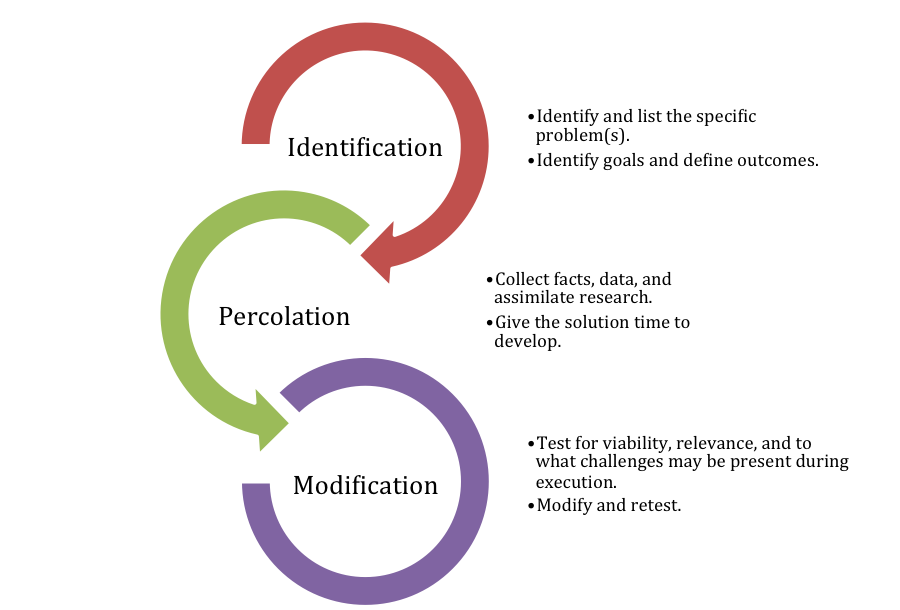Innovation and creativity are becoming increasingly valuable as the need for unique solutions to business problems becomes more salient. Cognitive psychologist Scott Barry Kaufman argues that the creative process can be viewed in four stages:
- Preparation – identify the problem and perform research
- Incubation – passive, unconscious period where innovation “percolates”
- Illumination – the innovation crosses the threshold of consciousness
- Verification – is the innovation viable? Meaningful? Executable?
On an academic level, this is interesting as it shows how the creative process works, but a more actionable process model is needed to help harness these creative forces for use as business solutions.
Applied Innovation Process Model
This model is designed to help guide the process of innovation and creativity in problem-solving.

At the risk of?oversimplification, we can view?creativity and innovation as a process of “connecting the dots” between any number of different concepts, ideas, or component parts. A good visual metaphor is a child piecing together something unique out of toy blocks. No two children will build the same structure, just like no two firms will create or innovate the same product, service, or process given the same raw material.
Identification
The first step in the model is to identify, define, and articulate the problem. Brainstorming and mind mapping are valuable for some of the more complex problems. Determine the goals and what barriers or obstacles stand in the way of attaining them. For example, in the context of e-commerce, the problem may be low market share. Some corresponding goals may be to increase sales and customer loyalty. By how much? Possible barriers include oversaturation, lack of product differentiation, or manufacturing difficulties. Refine the goals until they are realistic, specific, and measurable. Establish metrics so progress can be tracked and?evaluated.
A dialectical approach is especially helpful during this process. A person argues a premise, another offers a contradictory argument, or an antithesis (this could be a devil’s advocate approach), and finally a synthesis is reached. Don’t be afraid of conflict during this stage, be afraid of a lack of conflict. By the end of this stage, everybody involved in the process should have a clear understanding of the big picture.
Percolation
The next step is to collect data, do research, and explore ideas. Once you have reached a saturation point, and you will know it when you get there, allow time for the ideas to ferment and percolate. This is a passive process whereas the mind starts connecting the dots.

This is one of the reasons many companies have implemented strategies such as results-oriented work environments, or ROWE. They offer greater flexibility to allow for the creative process to occur naturally. Google famously adopted a program that allowed employees to spend 20% of their time working on projects or ideas that they felt would benefit the company. The program was implemented for years and evolved with the changing needs of their business. This is also why it is a good idea to give employees access to recreational activities such as air hockey tables and skee ball machines (like we have in the Insivia office). Beyond the benefit of having fun, social activities that employees can use to blow off steam and increase morale, they offer a distracting, non-taxing activity that will allow the percolation process to go unabated. Ask any creative writer or musician about the times when they were struck with?inspiration – the precious “ah-ha!” moments – and you will likely discover that they seldom occur on-demand, and instead during relatively mindless activities.
Modification
Once inspiration hits, the real work begins. One of the reasons why innovation is so difficult?is that many ideas, though wonderful in a vacuum, may not be realistic or plausible. The technology or means to realize them may not be available or could be cost-prohibitive. If this is the case, take great care to pack these ideas away somewhere safe as they may still prove to be valuable. If innovation can be executed, it is important to test its viability and relevance. Does it sufficiently solve the problem(s) that you have identified? The key word here is sufficiently, as an insufficient?solution is sometimes worse than no solution at all. If you find yourself with an insufficient solution, instead of scrapping it altogether, consider running it through the process again. Treat it like a piece of clay that needs to be shaped, sculpted, then fired to harden?it. Take a dialectical approach to evaluating the solution and be open to modifying it when necessary. Ideas rarely, if ever, come out of the box ready to go. Be patient and flexible.
Check out our portfolio to see examples of some innovative approaches we have taken to?marketing and web design.
